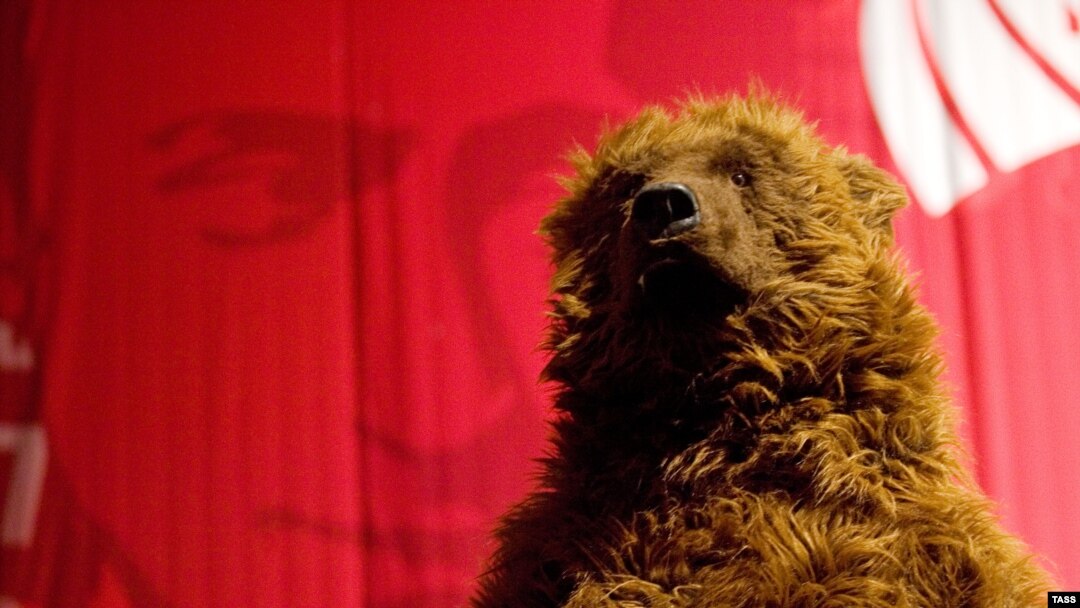Behind them, two giant speakers blare out a jazzed-up version of "Katyusha," the Soviet Union's most famous military song, while half a dozen older teenagers in matching red tops try to keep the children's spirits up.
The children are members of Mishki, a children's movement set up last year by members of the government-funded Nashi youth organization.
The organizers insist the Mishki (Teddy Bears) have no political associations, and that their connections with Nashi are purely coincidental. Yulia Zimova, the 20-year-old founder of Mishki, says there's no connection between the Teddy Bears and Nashi.
"At the moment I'm a 'commissar' with the Nashi movement, and there are maybe two or three more organizers who are also Nashi commissars," Zimova says, referring to her status as a senior Nashi organizer. "But all the others, including the Mishki leaders in other cities, aren't from Nashi. Most of the Mishki guides are in their final years at teacher's college -- they don't have anything to do with Nashi."
Any confusion, however, is understandable. For one, Mishki's nerve center is located inside Nashi's national headquarters -- an imposing three-story building north of the city center, surrounded by a high fence and with an armed guard at the entrance.
Inside, the walls and floors are painted red -- Nashi's color -- and pasted with Nashi flags and hundreds of photographs of Nashi members at rallies up and down the country. In a crimson-colored room on the second floor, four Mishki leaders are hard at work organizing trips to Lipetsk, Tambov, Saransk and Belgorod, some of the 20 cities in European Russia where the Mishki have set up shop.
'Things Can Be Different'
Today, Zimova says, there are 1,000 Mishki guides and 3,000 Mishki children, aged from 7 to 15. She says the aim of setting up the movement was to save the youngest generation of Russian children from being lost to more insular, commercial concerns.
"Our principle aim is to teach children to be in charge of their own lives, to teach them to take care of their surroundings, from the very youngest child to the very oldest," Zimova says. "We want to teach them that if they care about their own surroundings, they will care about their region, their city, their country."
She adds that "all we can do at the moment is provide an alternative -- we'll show it is possible to drag a child away from the computer or the television screen and show him there is an alternative, things can be different."
But these are political times in Russia, and although organizers claim the Mishki are simply a social movement, critics say their latest outing to the capital had a clear ideological aim.
Last year, Nashi and other pro-government youth groups camped outside the Estonian Embassy for over a week, throwing eggs and paint at the building and forcing the Estonian ambassador to leave the country temporarily.
The demonstration came after Estonian authorities moved from central Tallinn a statue of a Russian soldier, known as the 'Bronze Soldier,' which commemorates the loss of Russian and Soviet lives during World War II.
Estonian officials reasoned that they were relocating the statue because it had become the venue for clashes between the country's Russian and Estonian populations. Nashi and other youth groups saw the move as a slight to Russia and, with what was widely considered strong backing from the Kremlin, they launched verbal attacks on the Estonian government.
Vanya's War
At the Mishki gathering outside the Estonian Embassy last week, few of the children appeared to know what they were doing there, or what the Bronze Soldier in the poster they were coloring represented.
One Mishka told RFE/RL his name was Vanya and that he'd just wanted to come to Moscow on the bus. When asked why he had joined the Mishki, he said he didn't know.
Overall, the Nashi members shepherding the Mishki appeared reluctant to let journalists speak to the children in the group. At one point, a minder shouted at a correspondent not to "hold up" the children, then brusquely elicited a group farewell from the Mishki and urged them back on the bus to Vladimir.
Given the trip to the Estonian Embassy, the Bronze Soldier poster, and the Nashi connection, the choice for Mishki's ideological leader is hardly surprising. For Zimova, Russian President Vladimir Putin was the obvious candidate.
"We've asked Putin to be the leader of the Mishki movement, firstly because he's our national leader, and secondly because he's a respected figurehead who is the perfect example for children to follow," Zimova says. "One isn't ashamed of him -- he's the president, and the pride of the nation, not just from the political perspective, but from the human perspective."
Putin has yet to answer their request. But the signs are that his likely successor, Dmitry Medvedev, will be well-placed to take the position. "Medved," after all, is Russian for "bear."
Masha Lipman, a political commentator at the Moscow Carnegie Center, says the appearance of the Mishki was an alarming development -- and reminiscent of Soviet-era groups like the Young Pioneers and the Little Octobrists.
"I think any youth organization directed and guided from above brings back very unpleasant associations with the Soviet days. And also Nashi, I think, is a very unsavory organization, given their record of harassing officials, of enjoying complete impunity," Lipman says. "So [the fact that they are] ideological guides to still younger kids -- to me it's a very unpleasant trend."


